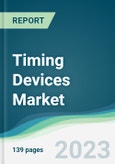The global timing devices market is projected to witness a compound annual growth rate of 6.17% to grow to US$8.026 billion by 2028, from US$5.279 billion in 2021.
Timing devices have multiple usages and the demand for these is anticipated to increase due to their various benefits. Crystal-based timing devices have a wide range of safety applications such as brakes, control systems, airbags, anti-locking systems, and tire pressure monitoring systems as well.Growth Drivers of the global timing devices market
Increasing investment in research and development of microelectromechanical system devices is further driving market growth. Moreover, with the increase in Internet of Things (IoT) and 5G technologies the timing devices market is anticipated to boost in the projected period.Increasing use of timing devices in various end-user industries
China holds a unique position when it comes to the production of timing devices as it has a strong position in semiconductor manufacturing, and consumer electronics, and a solid base in producing telecommunication devices. The production of temperature-compensated oscillators in China is also one of the growing sectors in the timing devices market. The Mobile World Congress Shanghai 2021 announced an investment of CYN 260 billion in building the world’s largest 5G network in the world. According to the Ministry of Industries and Information Technology (MIIT), the telecom business is expected to rise at 8% CAGR in the coming years. As such projects gain popularity in the world, the demand for timing devices for such projects is anticipated to increase in the coming years.Use of timing devices in the automotive sector
As per the report by the European Automobile Manufacturers' Association, more than 70% of cars use timing devices to keep complex automotive system operations in harmony. The use of timing devices in the automotive sector for accuracy to zone control is increasing the demand for this device in the market. The production of motor vehicles in the year 2022 was 85.4 million, a 5.7% increase compared to the previous year. The automotive industry is at a surge and is anticipated to grow in the coming years. The car navigation, audio systems, infotainment system, ADAS (smart driving assistance system), and various safety control features make use of timing devices. With the increasing use of timing devices in the end-user industry such as automotive and telecommunication the market demand for timing devices is projected to increase in the coming years.Asia Pacific is an Expected Dominant Market
The booming electronics demand coupled with well-established semiconductor and automotive sectors are acting as prominent driving factors for the regional market growth.In India, the market is expected to grow significantly.
Timing devices are used to provide timing signals which enable transmitting information at ideal speed thereby promoting synchronization among electronic devices mainly mobiles, computers, and radios. The booming consumer electronics production in India coupled with growing smartphone penetration has provided a major scope for the market demand for timing devices in the country. According to the Press Information Bureau, in 2021, India’s mobile production reached crores units signifying a major increase of 433% in production scale in comparison to 2014-2015. Furthermore, according to the November 2022 press release given by the Ministry of Information and Broadcasting, the number of smartphone users in India stood at 600 million.Besides the growing consumer electronics sector in India, various schemes and incentives undertaken by the Indian government to promote smart manufacturing are also acting as an additional driving factor for the timing device market growth.
Key Developments
- In December 2021, Renesas Electronics Corporation a premier supplier of innovative semiconductors, launched two new timing devices and controllers which are specifically designed for automotive accuracy and sensor-controlling applications that provide the supporting edge in the electronic and electrical architecture of the next generation.
- In February 2021, the launch of the “Production Linked Incentive Scheme” by the Indian government was a significant step taken towards promoting smart manufacturing in India. Additionally, the surge in automotive production and the growing shift towards EV adoption is further expected to propel the market growth.
Segmentation:
By Type
- Oscillators
- Semiconductor Clocks
- Resonators
By Application
- Industrial
- Consumer Electronics
- Telecommunication
- Automotive
- Healthcare
- Others
By Geography
- North America
- United States
- Canada
- Mexico
- South America
- Brazil
- Argentina
- Others
- Europe
- United Kingdom
- Germany
- France
- Spain
- Italy
- Others
- Middle East and Africa
- Saudi Arabia
- UAE
- Israel
- Others
- Asia Pacific
- Japan
- China
- India
- South Korea
- Indonesia
- Taiwan
- Thailand
- Others
Table of Contents
1. INTRODUCTION
2. RESEARCH METHODOLOGY
3. EXECUTIVE SUMMARY
4. MARKET DYNAMICS
5. GLOBAL TIMING DEVICES MARKET, BY TYPE
6. GLOBAL TIMING DEVICES MARKET, BY APPLICATION
7. GLOBAL TIMING DEVICES MARKET, BY GEOGRAPHY
8. COMPETITIVE ENVIRONMENT AND ANALYSIS
9. COMPANY PROFILES
Companies Mentioned
- NXP Semiconductors
- Texas Instruments Incorporated
- Murata Manufacturing Co., Ltd
- Seiko Epson Corp
- Seiko Time Creation Inc.
- Abracon
- STMicroelectronics
- Rakon Limited
- Microsemi Corporation
- Microchip Technology Inc
Methodology

LOADING...
Table Information
| Report Attribute | Details |
|---|---|
| No. of Pages | 139 |
| Published | October 2023 |
| Forecast Period | 2021 - 2028 |
| Estimated Market Value ( USD | $ 5.28 Billion |
| Forecasted Market Value ( USD | $ 8.03 Billion |
| Compound Annual Growth Rate | 6.1% |
| Regions Covered | Global |
| No. of Companies Mentioned | 10 |









